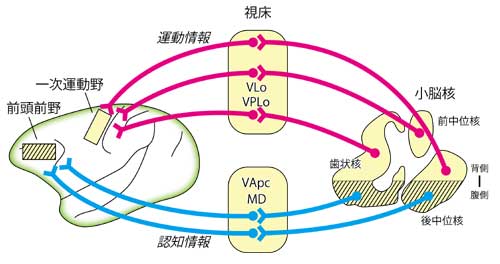Anatomical evidence for the involvement of medial cerebellar output from the interpositus nuclei in cognitive functionsXiaofeng Lu, Shigehiro Miyachi, and Masahiko Takada Although the cerebellar interpositus nuclei are known to be involved in cognitive functions, such as associative motor learning, no anatomical evidence has been available for this issue. Here we used retrograde transneuronal transport of rabies virus to identify neurons in the cerebellar nuclei that project via the thalamus to area 46 of the prefrontal cortex of macaques in comparison with the projections to the primary motor cortex (M1). After rabies injections into area 46, many neurons in the restricted region of the posterior interpositus nucleus (PIN) were labeled disynaptically via the thalamus, whereas no neuron labeling was found in the anterior interpositus nucleus (AIN). The distribution of the labeled neurons was dorsoventrally different from that of PIN neurons labeled from the M1. This defines an anatomical substrate for the contribution of medial cerebellar output to cognitive functions. Like the dentate nucleus, the PIN has dual motor and cognitive channels, whereas the AIN has a motor channel only. Proceedings of National Academy of Science USA; 109(46): 18980-18984, 2012 Organization
of multisynaptic inputs from the cerebellar nuclei to the primary motor
cortex and the prefrontal cortex

Motor information from the dorsal parts of the posterior interpositus
nucleus (PIN) and the dentate nucleus (DN) and the anterior interpositus
nucleus is directed toward the primary motor cortex via the thalamus,
whereas associative information from the ventral parts of the PIN and DN
is directed toward the prefrontal cortex.
NOV/22/2012
Copyright(C) 2012 PRI ( ).
All rights reserved. ).
All rights reserved. | 



